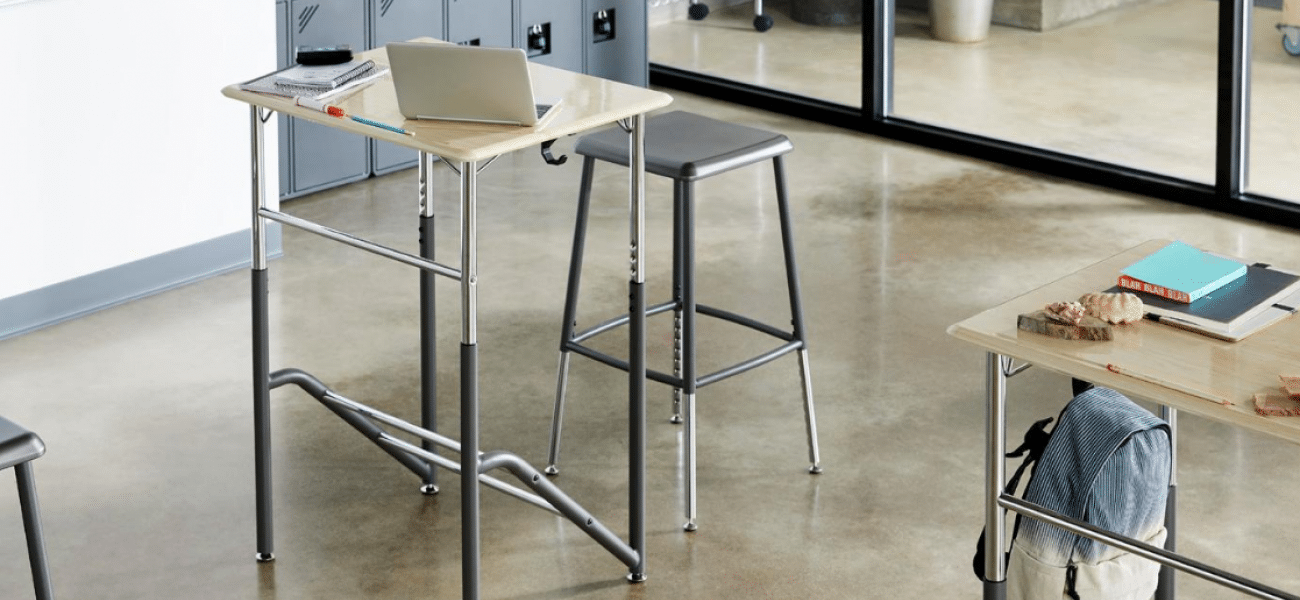Education, it’s been said by many, is the foundation of the future. And what better place to invest than in the future of our children and our society?
It’s a goal of every educational institution (we hope) to empower children and young adults to reach their full potential. In an effort to make that goal a reality, let’s begin in the classroom.
Furniture may not be the first thing that comes to mind when considering how to maximize success in the classroom, but perhaps it should be. In an article titled the “Most Painful Days of Your Life,” the author discusses a study showing that inappropriate classroom furniture can cause a lifetime of chronic pain, not to mention a negative impact on learning.
The importance of classroom furniture goes beyond a child’s muscular development. Educators routinely see how the right (or wrong) furniture can also impact focus, time management, collaboration, and engagement in the classroom.
So, with that in mind, take a look at a few suggestions to ensure your classroom is equipped with the ideal furniture solutions.
Chairs
Teachers are trained to educate students of varying capabilities using different techniques to get a message across. While educators understand that each student has unique mental needs, the fact that everyone also has unique physical needs sometimes gets forgotten.
We can’t simply assume that one style of chair will suit the needs of every student. Rather, the classroom will benefit from a variety of seating options. As such, suppliers offer all sorts of specialty classroom seating in addition to the standard classroom chair. From stable bouncy chairs to rocker seats and floor cushions to beanbag chairs, there’s an option available for each child in the classroom.
Desks
Walking into a progressive classroom, you may see kids reading on yoga mats, using the window as an idea board, or collaborating in a circle on floor cushions – and that’s great. Flexible, movement-based classrooms are the future.
Despite this, there’ll likely always be a need for student desks. And thankfully, student workstations now come in all shapes and sizes, with options for reconfiguration and adjustment – making both the student and teacher experiences more enriched.
Seven Things to Consider Before Buying School Furniture
There’s a Chinese proverb that says, “Do not confine your children to your own learning, for they were born in another time.”
This aphorism is likely more true of today’s children than of any previous generation. Thanks in large part to rapid technological growth, the modern child (and the modern classroom) bears little resemblance to the past.
While traditional teaching consisted of the “stand and teach/sit still and listen” format, today’s teachers understand this isn’t ideal. Instead, educators must work harder to engage students in active learning, knowing that people learn best by doing.
And since we’re seeing more movement and collaboration in the classroom, functional furniture is crucial. So, before investing in new school furniture, here are seven factors to consider:
Health and Safety
Even the best educators will struggle to effectively engage students in an unsafe classroom. As such, student safety unsurprisingly tops our list of priorities. Not only should furniture be sturdy, but it should also be constructed from non-toxic materials.
Ergonomics
Nowhere is proper ergonomics more important than in the classroom. Students come in all shapes and sizes, and it’s important to respect such diversity. To address the discrepancies between students, desks and chairs come in adjustable heights.
Flexibility
From the workplace to the classroom, there’s been a shift toward flexible workstations. People learn (and work) best in a variety of settings, and what’s best for one will be far from ideal for another. Instead of purchasing identical furniture for every student, consider a mixture.
For many, the traditionally structured desk and chair will function perfectly. However, some students need to move and fidget more, in which case, chairs that bounce or tilt will support better concentration. Giving students a choice in furniture empowers them to determine how they learn best.
Mobility and Function
Today’s educators don’t spend the entire day simply lecturing the students (while expecting them to sit still and listen). Rather, to promote engaged learning, they’re actively involving their students in the learning process. From one hour to the next, the classroom may transform from a historic battle site to a boardroom to a science lab and finally into a standard classroom. With that in mind, classroom furniture should move and reconfigure smoothly between lessons.
Value
The budget carries a lot of weight when it comes to purchasing classroom furniture. Of course, it’d be great to outfit the school in the best money can buy, but as we all know, there is a finite amount of resources in the education system.
As a result, getting the best value for price is extremely important. Materials should be scratch resistant, easy to clean, and durable enough to withstand constant use and abuse.
Service
Of course, we never want to plan for issues after making such a large investment, but in the event of a problem, it’s wise to have backup. This is especially true in the case of classroom furniture, which sees a lot of wear and tear. Product warranty, service quality, and even delivery time should factor into the purchase decision.
Technology
The classroom is undergoing major changes as technology use seeps into teaching methodologies. For this reason, much of the furniture being designed for schools makes integration seamless. It makes financial and practical sense to invest in furniture that will accommodate technological growth in years to come.
This article is courtesy of CDI Spaces, which has passion for creating spaces that facilitate engaged learning, wellness, and productivity, www.cdispaces.ca.








